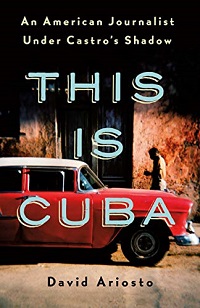Portraits of Cuba | History Reviews
Cuba watchers should read this informative new work, as should all interested in a country that is geographically closer to the United States than some might realize; if you read only one recent book on Cuba, have it be this delightful popular history

![]() Ariosto, David. This Is Cuba: An American Journalist Under Castro’s Shadow. St. Martin’s. Dec. 2018. 304p. notes. index. ISBN 9781250176974. $28.99; ebk. ISBN 9781250176981. TRAV
Ariosto, David. This Is Cuba: An American Journalist Under Castro’s Shadow. St. Martin’s. Dec. 2018. 304p. notes. index. ISBN 9781250176974. $28.99; ebk. ISBN 9781250176981. TRAV
Photojournalist Ariosto spent 2009–10 on assignment in Havana, Cuba, and has regularly returned to the country ever since. His accounts are part memoir, part reflection of a broken country still under the sway of Cold War beliefs despite recent signs of economic and social recovery after the overtures of President Obama’s efforts to restore U.S.-Cuba relations in 2014. Ariosto sees few differences between Cuban leaders Fidel and Raúl Castro. Even with the return of American tourists and improved Wi-Fi, the transition to economic and cultural opportunity is still in flux and the Cuban future uncertain. A chapter on the black market, or shadow economy, holds little promise for the country’s success. As one pensioner who fought under the Cuban flag in Angola states, “in Cuba you don’t live but survive—on $13 a month.” Ariosto’s work is at times chilling, but with a touch of nostalgia and humor.
VERDICT Cuba watchers should read this informative new work, as should all interested in a country that is geographically closer to the United States than some might realize.—Boyd Childress, formerly with Auburn Univ. Libs., AL

![]() Perrottet, Tony. Cuba Libre! Che, Fidel, and the Improbable Revolution That Changed World History. Blue Rider: Penguin. Jan. 2019. 384p. illus. maps. notes. index. ISBN 9780735218161. $28; ebk. ISBN 9780735218185. HIST
Perrottet, Tony. Cuba Libre! Che, Fidel, and the Improbable Revolution That Changed World History. Blue Rider: Penguin. Jan. 2019. 384p. illus. maps. notes. index. ISBN 9780735218161. $28; ebk. ISBN 9780735218185. HIST
Perrottet (Pagan Holiday) tackles Cuba’s revolutionary era, from late 1956 through 1960. Starting with the Granma fiasco and the failed attack on the Moncada Barracks to the overthrows of the Batista regime, the author drops readers into the middle of a revolutionary movement unlike any other in history. He contends the leadership was naïve, inexperienced, and idealistic, yet, somehow this amateur band of revolutionaries succeeded. We follow Fidel and Raúl Castro and Che Guevara but also meet figures such as Camilo Cienfuegos, Celia Sánchez, and Haydée Santamaría. Indeed, the uprising may well have collapsed without the organizational abilities of Sanchez. Perrottet’s access to written and oral records provides for a rare achievement in the corpus of Cuba’s revolutionary literature, with the remarkable epilog recounting the postrevolutionary lives of the major players.
VERDICT An excellent new entry on the subject, with a memorable opening line and highly enjoyable chapters. If you read only one recent book on Cuba, have it be this delightful popular history.—Boyd Childress, formerly with Auburn Univ. Libs., AL
RELATED
ALREADY A SUBSCRIBER? LOG IN
We are currently offering this content for free. Sign up now to activate your personal profile, where you can save articles for future viewing









Add Comment :-
Comment Policy:
Comment should not be empty !!!